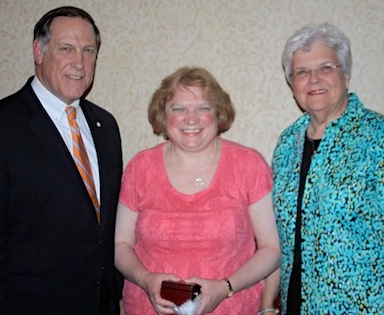Growing Problem Nationwide
When a mentally ill patient arrived at AnMed Health Medical Centers’ emergency room in May, staff at the Anderson, South Carolina, facility scurried to find a hospital with enough room for an admission.
Everywhere was full, including a nearby psychiatric hospital. Unable to find any place that had available beds, the patient spent 13 days languishing in the ER. Such stays are increasingly common at the hospital -- in one case last year a patient was stuck in the ER for 38 days, costing the hospital $56,392 on extra nursing, security and physician care.
“It’s a continuous onslaught,” said David Cothran, director of emergency services at AnMed Health. “Budget cuts for outpatient and inpatient psychiatric care have made the ER the safety net. It’s unreal.”
U.S. hospital emergency rooms are becoming holding pens for psychiatric patients. People are being kept on site for days and sometimes weeks, a symptom of an overtaxed health system grappling with steep cuts to mental-health services. The number of psychiatric beds nationwide has decreased by at least 14 percent since 2005, according to the Treatment Advocacy Center, a nonprofit group that focuses on severe mental illness.
At the same time, almost 15 million visits to hospital emergency departments in 2010 involved a mental health or substance abuse diagnosis, according to the Rockville, Maryland-based Agency for Healthcare Research and Quality. That’s up from about 10 million in 2005.
Perfect Storm
That number will probably soon rise dramatically. The U.S. Affordable Care Act, which begins its main expansion of health insurance Oct. 1, will extend coverage for about 25 million Americans who are now uninsured. Various provisions require benefit packages to include treatment for mental health by fiscal year 2014, according to the Substance Abuse and Mental Health Services Administration website.
The increase in patients with mental health coverage will likely overwhelm existing community-based treatment programs and providers, which may drive even more psychiatric patients to the ER, Mark Pearlmutter, a spokesman for the American College of Emergency Physicians, said in an interview.
“We already have the perfect storm of psychiatric patients in the ER, and until there are more resources, it will worsen,” he said. “Most hospitals are already at capacity and the extra volume and boarding would be extremely challenging.”
Holding the mentally ill endangers other patients because it ties up staff, adds to ER crowding, and leads to longer waits, said Robert Bitterman, president of Harbor Springs, Michigan-based Bitterman Health Law Consulting Group Inc.
Satan Fears
Cathy Heinz, 38, a lactation consultant in Virginia Beach, Virginia, has brought her 66-year old mother to the ER about eight times in four years, she said. Her mother has early-stage dementia and schizoaffective disorder, which can lead to abnormal mood and psychosis. In a crisis, she’ll think Satan is after her or that others are trying to kill her, she said.
The situation is often too extreme to first bring her to her doctor, Heinz said.
Every time she heads to the emergency room, Heinz packs a bag of crackers and other snacks because she knows it may be days before her mother gets a bed in a hospital psychiatric clinic. In November 2011, she stayed with her mother in the ER for about three days at Sentara Norfolk General Hospital (127917MF) in Norfolk, Virginia, she said. During another three day stay in February, Heinz said nurses asked her to lock herself in a room with her mother because another patient was out of control.
Psychiatric Unit
Sentara Hospital declined to comment on Heinz’s experience due to patient confidentiality, Dale Gauding, a spokesman, said in an interview. Sentara Healthcare in December will open a 24-bed inpatient general psychiatric unit that also serves geriatric patients at Sentara Virginia Beach General Hospital, partly to alleviate boarding in the ER, he said.
Virginia Beach has seen a doubling in psychiatric consults done in the ER over the past five years, Joanne Inman, vice president of operations at the hospital, said in an interview.
Security is often insufficient at some emergency departments and patients have escaped or become violent during their long stays, Heinz said.
“One time, someone broke out and was biting a nurse,” said Heinz. “One time I had to hold my mother back because I thought she was going to attack a doctor.”
Timely Manner
Almost 90 percent of emergency department administrators say they’re often or sometimes unable to transfer mental health patients in a timely manner, according to a 2010 study by Lafayette, Louisiana-based Schumacher Group, an ER management company.
More than 70 percent say they board these patients for 24 hours or longer, and 10 percent said they keep them a week or more.
Of the almost 129 million visits to U.S. hospital emergency rooms in 2010, an estimated 14 million involved mental health diagnoses and almost 40 percent of those patients were admitted to the hospital from the emergency room, according to the most recent data from the Agency for Healthcare Research and Quality.
Andre Walker, a 27-year-old schizophrenic who loved writing rap music and lived with his mother, was brought by ambulance to Cape Fear Valley Medical Center in Fayetteville, North Carolina, in April 2011 because he was having a psychiatric emergency.
An ER doctor evaluated him and decided at 6:45 p.m. that he needed to be committed to a mental health facility, according to a lawsuit filed in state court in Fayetteville. Cape Fear last year settled the lawsuit out of court for an undisclosed sum.
No Beds
At 8 p.m., there were still no available beds at several locations, according to the lawsuit, and Walker became more agitated. Around 9:20 p.m., Walker tried to leave. He was restrained by company police and security officers, according to the lawsuit.
One officer grabbed Walker in a choke hold and pulled him to the floor, according to the lawsuit, and three other officers grabbed other parts of his body. After a few minutes of struggle, Walker became unresponsive and was tied down with leather restraints, according to the lawsuit. Staff tried to resuscitate him and he died, based on the complaint.
The medical examiner concluded Walker died due to suffocation by restraint, the lawsuit states.
“Medical facilities should have someone in the ER that knows how to deal with patients who have a mental disorder,” said Andre’s mother, Valerie Walker, 54. “If they keep them there, if they board them there for hours, they should have a designated area for them and people who are trained deal with them.”
Lock Down
The lawsuit has been resolved to the mutual satisfaction of all parties, Lou Patalano, general counsel and senior vice present of legal services at Cape Fear Valley Health System, said in an interview. He declined to comment further.
Keeping mentally ill patients in the ER is expensive. Strong Memorial Hospital in Rochester, New York, has a locked, psychiatric emergency room on the floor above the main emergency room. It has safety features such as unbreakable glass windows where patients can be triaged quickly by a psychiatrist and a resident.
Oconee Medical Center’s ER in Seneca, South Carolina, has spent $21,060 this year on sitters to monitor psychiatric patients and has a room with cameras for violent patients.
“What do we do if they want to leave? I’m not going to go out in the parking lot and wrestle them,” Edwin Leap, an emergency room doctor, said in an interview.
Suicidal Patient
On a recent spring night at University of California San Diego Health System’s Hillcrest ER, a suicidal patient slumbered in a room with the lights kept off. He wakened to talk to the rushed ER doctor, James Dunford, who is also medical director for the city of San Diego’s emergency medical services system. Dunford assured him the hospital was trying to find an available bed. Until then, he’d have to stay in the ER.
In the doorway, the hospital posted an emergency department technician who makes as much as $25 an hour to keep watch around the clock. The sitter quietly thumbed through a dog-eared novel. Two other psychiatric patients were also being held in the room. At Hillcrest, one technician may watch up to three patients.
There are only 45 beds for the uninsured at the nearby county psychiatric hospital, and when they’re full, patients without coverage wait in the ER while staff calls around trying to find a place to take them. Between 1995 and 2010, the state lost 3,000 beds, almost a 30 percent drop, for psychiatric inpatient care than in 1995, according to the California Hospital Association report.
“It’s a real challenge,” says Dunford. “There are not enough beds, so we have to keep them here. It ties up beds, resources and staff.”
AnMed Health’s Cothran agrees. “You can’t get angry at the patient, they need the help,” he said. “Then when you have someone who acts up, it’s distressing to the little grandmother who is just waiting in the ER for care.”
To contact the reporter on this story: Stephanie Armour in Washington at sarmour@bloomberg.net
 Thursday, July 18, 2013 at 10:23AM
Thursday, July 18, 2013 at 10:23AM 








